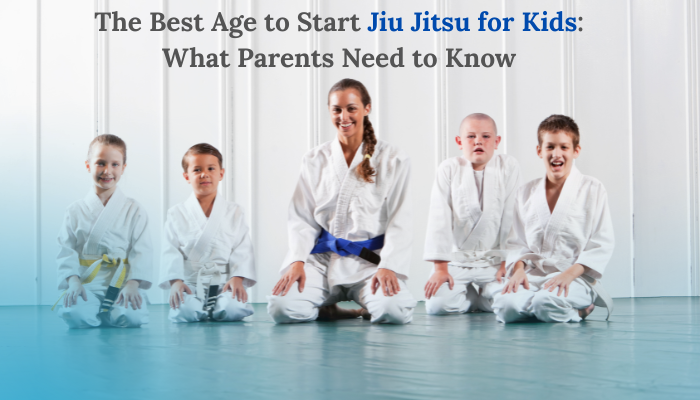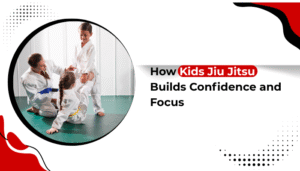The Best Age to Start Jiu Jitsu for Kids: What Parents Need to Know
Jiu jitsu for kids is more than just a sport it’s a powerful tool for building discipline, confidence, coordination, and...

Jiu jitsu for kids is more than just a sport it’s a powerful tool for building discipline, confidence, coordination, and self-defense skills. As more parents seek enriching activities for their children, Brazilian Jiu Jitsu (BJJ) stands out as a popular choice. But a common question often arises: What is the best age to start jiu jitsu for kids?
In this post, we’ll explore this topic in depth, offering guidance and insights to help parents make informed decisions.
What Is Jiu Jitsu for Kids?
Jiu jitsu for kids is a modified version of Brazilian Jiu Jitsu designed specifically for younger practitioners. Unlike adult classes, kids’ BJJ classes are focused on fun, safety, learning the basics, and gradually developing skills through age-appropriate instruction. These programs prioritize technique over strength and teach children how to use leverage and body positioning rather than brute force.
Jiu jitsu emphasizes ground control, submissions, and escapes making it ideal for self-defense without promoting aggression. Kids learn to stay calm under pressure, respect boundaries, and improve both physically and mentally.
The Ideal Age to Begin Jiu Jitsu for Kids
While some schools start accepting children as young as 3 or 4 years old, the ideal age to start jiu jitsu for kids typically falls between 5 to 7 years old. At this age, children usually have enough motor skills, attention span, and emotional maturity to benefit from structured martial arts classes.
Let’s break it down:
- Ages 3-4– Introduction to movement, balance, and basic coordination. Classes are playful and short.
- Ages 5-7– Great for foundational techniques, learning discipline, and following instruction.
- Ages 8-12– Prime time for building strong technical skills and understanding strategy.
- Teens– Ideal for competitive aspirations or transitioning into adult classes.
Every child is different, so readiness depends more on the individual’s development than the number on the calendar.
Benefits of Starting Jiu Jitsu at a Young Age
1. Building Confidence and Self-Esteem
Jiu jitsu for kids fosters a deep sense of self-worth through achievable goals, belt progressions, and personal accomplishments. As children gain skills and earn stripes or belts, they develop pride in their abilities.
2. Promoting Physical Fitness and Coordination
Jiu jitsu improves strength, balance, agility, and flexibility. These physical benefits often transfer to other sports and physical activities.
3. Learning Respect and Discipline
Respect for instructors, training partners, and the art itself is a core part of BJJ. Kids learn to listen, follow rules, and act with humility.
4. Enhancing Focus and Emotional Control
The structure of jiu jitsu classes helps children stay focused, manage frustration, and think before reacting—skills that benefit both academics and relationships.
What Parents Should Look for in a Kids’ Jiu Jitsu Program
1. Qualified Instructors Who Specialize in Jiu Jitsu for Kids
Look for instructors with experience teaching children. Great kids’ coaches are patient, positive, and know how to balance structure with fun.
2. A Safe and Supportive Environment
The school should prioritize safety with proper mats, a clear code of conduct, and well-supervised classes.
3. Age-Appropriate Curriculum
Children should be grouped by age and skill level. Programs tailored for different age brackets (3–4, 5–7, 8–12, etc.) ensure everyone gets the right balance of challenge and support.
4. Positive Community and Culture
A welcoming culture encourages growth. Jiu jitsu for kids should never be about aggression it should focus on respect, effort, and mutual improvement.
Common Concerns Parents Have
“Is Jiu Jitsu Safe for My Child?”
Yes when taught correctly, jiu jitsu is one of the safer martial arts for kids. Since it’s a grappling-based art (no striking), the risk of serious injury is relatively low. Good instructors emphasize control, not competition.
“What if My Child Is Shy or Not Athletic?”
Perfect! Jiu jitsu for kids is particularly effective for shy, anxious, or non-athletic children. It’s about personal growth, not beating others. Many children who struggle in team sports thrive on the mat because of the individual attention and progress tracking.
How Often Should Kids Train Jiu Jitsu?
For beginners, 2 classes per week is ideal. This allows enough time to absorb techniques and build consistency without feeling overwhelmed. As they grow more comfortable, kids can train more frequently especially if they’re interested in competition.
Consistency is more important than intensity. Long-term progress in Bjj for kids comes from steady, regular practice and positive experiences.
Signs Your Child Is Ready to Start Jiu Jitsu
- They can follow basic instructions for short periods.
- They show interest in martial arts or physical activities.
- They’re able to engage in cooperative play.
- They benefit from structured environments.
If your child ticks most of these boxes, they’re likely ready to give jiu jitsu a try.
Final Thoughts
Choosing the best time to begin jiu jitsu for kids ultimately depends on your child’s development, temperament, and interests. While ages 5 to 7 are a sweet spot, many younger children thrive in playful intro classes, and older kids can start strong too.
What matters most is finding a great school, staying consistent, and focusing on fun, growth, and learning. Brazilian Jiu Jitsu can be a life-changing experience that builds character, resilience, and community.
If you’re interested in reading more blogs explore this website- https://thenewsus.com/



